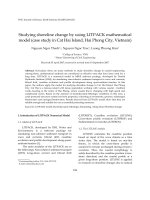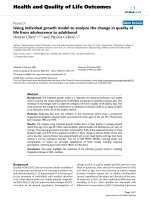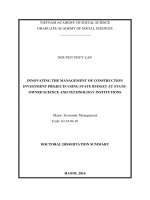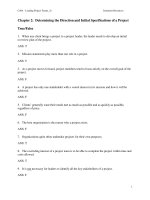change management describe team change journey using tuckmans change model address pitfalls mentioned by bion
Bạn đang xem bản rút gọn của tài liệu. Xem và tải ngay bản đầy đủ của tài liệu tại đây (2.21 MB, 27 trang )
<span class="text_page_counter">Trang 1</span><div class="page_container" data-page="1">
VIETNAM GENERAL CONFEDERATION OF LABOUR TON DUC THANG UNIVERSITY
FACULTY OF BUSINESS ADMINISTRATION
CHANGE MANAGEMENT
DESCRIBE TEAM CHANGE JOURNEY USING
<b>TUCKMAN’S CHANGE MODEL/ ADDRESS PITFALLS </b>
</div><span class="text_page_counter">Trang 2</span><div class="page_container" data-page="2">EVALUATION OF WORK PERFORMANCE LEVELS
No Full name Student ID Evaluation
1 Diệp Tuyết Nhi 720H1574 100%
2 Nguyễn Thị Xuân Mai 720H1389 100%
</div><span class="text_page_counter">Trang 3</span><div class="page_container" data-page="3">1.5 Tiki's Position in the Industry ... 9
CHAPTER 2: APPROACHES TO CHANGE PROCESS ... 11
1. Organization as machine ... 11
1.1. The definition of organizational as machine ... 11
1.2. Benefits of organizational as machine... 11
1.3. Limitations of organizational as machine ... 11
2. Organization as political system ... 11
2.1. The definiton of political system ... 11
2.2. Benefits of organizational as machine... 12
2.3. The limitations of this political metaphor ... 12
3. Organization as organisms ... 13
3.1. The definition of organizational as organisms ... 13
3.2. The benefit of the organization as organisms ... 13
3.3. The limitations of the organization as organisms ... 13
4. Organizational as the flux and transformation... 14
4.1. The definition of the organizational as the flux and transformation . 14 4.2. The benefits of the organizational as flux and transformation ... 15
4.3. The limitations of the organizational as the flux and transformation 15 CHAPTER 3: MODELS TO ORGANIZATIONAL TO CHANGE ... 16
1. Lewin three-steps model to organization change of Tiki ... 16
2. Lewin’s force field analysis ... 17
3. Driving and resisting forces ... 18
4. Apply Kotter eight-step model in Tiki ... 19
CHAPTER 4: CONCLUSION ... 26
</div><span class="text_page_counter">Trang 4</span><div class="page_container" data-page="4">REFERENCES ... 27
</div><span class="text_page_counter">Trang 5</span><div class="page_container" data-page="5">LIST OF FIGURE
Figure 1.Tiki's market share lags behind other e-commerce platforms. ... 9 Figure 2. Lewin three-step model implementing change at Tiki ... 16 Figure 3.Lewin's force field analysis ... 17
</div><span class="text_page_counter">Trang 6</span><div class="page_container" data-page="6">EVALUATION OF LECTURER
</div><span class="text_page_counter">Trang 7</span><div class="page_container" data-page="7">ACKNOWLEDGEMENT
First and foremost, my team would like to send our sincere thanks to Ton Duc Thang University for including the subject Change Management into the curriculum. In particular, we would like to express our deep gratitude to the subject lecturer - Mr. Hoang Kim Chuong for teaching and imparting valuable knowledge to us during the study period. During the time participating in the Change Management class, we gained a lot of useful knowledge and practical issues in business. This will certainly be valuable knowledge and a tool for us to apply in the future.
The subject of Change Management is an interesting, extremely useful and highly practical subject. Ensure to provide enough knowledge, linked to the practical needs of students. However, because knowledge is still limited and the ability to absorb reality is still confusing. Although we have tried our best, it is certainly difficult for this report to avoid shortcomings and many inaccuracies. We hope you will review and give us suggestions to make our report more complete.
Sincerely thanks!
</div><span class="text_page_counter">Trang 8</span><div class="page_container" data-page="8">CHAPTER 1: INTRODUCTION 1. Introduction to TIKI Corporation
1.1 Tiki Corporation
Tiki Corporation, a Joint Stock Company, was established in March 2010 by Mr. Tran Ngoc Thai Son, who currently serves as the CEO and Founder. Today, Tiki is recognized as an ecosystem that encompasses various elements, including the e-commerce website Tiki.vn, the logistics service Tikinow, and the trading unit Tiki Trading. Starting as an online book-selling platform, Tiki has achieved numerous milestones and emerged as one of the most successful businesses in the e-commerce sector.
The company's name is derived from combining the initial syllables of the Vietnamese words "Tìm kiếm" (Search) and "Tiết kiệm" (Save), reflecting its commitment to providing the best experience for customers.
1.2 Formation and Development Journey
Initially, Tiki began as a modest online bookstore with a capital of only $5,000. Facing various challenges and managing all aspects of the business, including administration, marketing, packaging, and shipping, CEO Son played a pivotal role. In March 2012, CyberAgent Ventures Inc decided to invest in Tiki, marking a turning point in its evolution into an e-commerce platform. In the years 2011-2012, Tiki dominated the book business segment in Vietnam. By 2013-2014, Tiki owned over 51,000 book titles nationwide and expanded into various other product categories. Recognizing the potential of e-commerce, Tiki transformed by utilizing a warehouse with an area exceeding 3,000m2.
From 2015 to 2017, Tiki continued its success, becoming the second-largest ecommerce company in Vietnam and ranking among the top 6 in the region, offering over 300,000 products across 23 different categories. Additionally, Tiki was recognized as the top-ranked brand for excellent customer experience in Vietnam in 2020, according to YouGov.
-1.3 Business Model
Initially focusing on the B2C (Business to Customer) model, Tiki conducted business operations and distributed books to users through its online platform. In April 2017, the company transitioned to a Marketplace model, allowing various distributors to collaborate and sell their products on the Tiki website, thereby expanding its range of products and services. Simultaneously, the Tiki Now fast delivery service within 2 hours was introduced in the same year, providing a significant advantage for Tiki over other brands in the industry.
</div><span class="text_page_counter">Trang 9</span><div class="page_container" data-page="9">1.4 Operating Philosophy
Operating under the motto "All for the Customer," Tiki is committed to constantly improving the quality of its services and products, aiming to provide an optimal shopping experience for domestic customers by fulfilling two criteria: Quality and Time. Tiki's policy of a 111% refund in case of counterfeit, substandard, or fake products is a clear testament to the company's commitment.
1.5 Tiki's Position in the Industry
Tiki is one of the major competitors of Shopee, Lazada, and other e-commerce platforms in Vietnam. It is renowned for its service quality and commitment to providing genuine products and customer care. According to market data from Metric, in the first quarter of 2023, the total revenue of the top 5 e-commerce platforms, including Shopee, Lazada, Tiki, Sendo, and Tik Tok Shop, amounted to 39 trillion VND. The total number of shops generating orders was 413, with 390 million successfully delivered products, representing a 21.8% growth in revenue compared to the same period last year.
Figure 1.Tiki's market share lags behind other e-commerce platforms. According to the 2023 E-commerce Report published by market research company Momentum Works, the total transaction value of goods on e-commerce platforms in Vietnam in 2022 reached 9 billion USD. Shopee dominated with a 63% share of the total GMV (Gross Merchandise Value), reaching around 5.67 billion USD (approximately 113.245 trillion VND). Lazada secured the second position with a GMV of around 2.7 billion USD (approximately 63.450 trillion VND), which is one-third of
</div><span class="text_page_counter">Trang 10</span><div class="page_container" data-page="10">Shopee's achievement. However, Tiki contributed only 6% to the total GMV of commerce in Vietnam, equivalent to 540 million USD.
e-Even the Tik Tok Shop platform, introduced just over a year ago, has approached Tiki's performance, achieving a total GMV of approximately 360 million USD."
</div><span class="text_page_counter">Trang 11</span><div class="page_container" data-page="11">CHAPTER 2: APPROACHES TO CHANGE PROCESS 1. Organization as machine
1.1. The definition of organizational as machine
An organization implies routine operations, well-defined structure and job roles, and efficient working inside and between the working parts of the machine (the functional areas). Specifically, that an organization works similarly to an engine. Within the engine, every part has a specific job to perform in order to make it work. It's like looking at the gears of a machine, they work in harmony to achieve a final result. 1.2. Benefits of organizational as machine
Facilitates understanding of how components interact: The machine metaphor provides a clear understanding of how components within an organization or system interact with each other to achieve common goals.
Enhances comprehension of the organization or system: This model clarifies the structure and workings of the organization, making it easy for people to visualize and understand how the organization operates.
Simplifies management and optimizes workflow: The machine metaphor helps manage and control internal processes, thereby optimizing operations and improving predictability.
1.3. Limitations of organizational as machine
Reduces flexibility and diversity in how organizations are managed: Treating an organization like a machine may diminish adaptability and flexibility in the face of rapid changes.
Cannot fully describe the complexity and dynamics of many modern organizations: The machine metaphor might overlook the complex and dynamic factors in today's business environment where change and diversity are inevitable.
May lead to misunderstandings when applying this model without considering all impacting factors on the organization: This limitation can result in inaccurate assessments when not thoroughly considering the diverse and motivating factors within the organization, thus, misunderstandings may arise in the management process.
2. Organization as political system2.1. The definiton of political system
Organizational management and political governance are closely related when we consider organizations to be political systems. Here, going to discuss the power rules that the organization employs.
Because it recognises the critical role that conflict, power, and opposing interests play in organizational life, the political metaphor is helpful. Many individuals believe that business and politics should be kept apart. According to Gareth Morgan, those who support workers' rights or industrial democracy are
</div><span class="text_page_counter">Trang 12</span><div class="page_container" data-page="12">not so much fighting for a political issue as they are arguing for a better way to handle a situation that is intrinsically political.
The main beliefs are:
You cannot stay out of organizational politics: you are already in it. Building support for your approach is essential if you want to make anything happen.
You need to know who is in power and who they are close to.
There is a significant political map that governs the published organizational structure.
The connection between individuals is more important than work groups. The most important decisions in an organization involve the allocation of scarce resources: who gets what and what is achieved through bargaining, negotiation, and jockeying for position.
This leads to the following assumptions about organizational change: Change will not be effective unless it is supported by those in power. The broader the support for this change, the better.
It is important to understand the political map and understand who will be the winners and losers as a result of this change.
Active strategies include creating new coalitions and renegotiating issues. 2.2. Benefits of organizational as machine
Here are some of the benefits of organizational politics:
<small>o </small> Building Relationships and Networks: Engaging in organizational politics often involves forging connections with others in the organization. This fosters greater collaboration and cooperation, ultimately benefiting the organization as a whole.
<small>o </small> Enhancing Organizational Understanding: Organizational politics can serve as a conduit for individuals to gain insights into the informal rules, norms, and prevailing power dynamics within the organization. This knowledge aids in navigating the organization effectively and achieving personal goals.
<small>o </small> Developing Political Skills: Mastery of organizational politics necessitates the ability to navigate complex relationships, build alliances, and persuade others. These skills are valuable not only in the workplace but also in various aspects of life.
<small>o </small> Driving Change and Innovation: Organizational politics can be a catalyst for challenging the status quo and advocating for change. While individuals may initially be driven by self-interest, their actions can result in broader changes that benefit the organization as a whole.
</div><span class="text_page_counter">Trang 16</span><div class="page_container" data-page="16">CHAPTER 3: MODELS TO ORGANIZATIONAL TO CHANGE 1. Lewin three-steps model to organization change of Tiki
Lewin's Three-Step Model is a framework for understanding and managing organizational change. It consists of:
<small>o </small> Unfreezing: This stage involves preparing the organization for change by creating the motivation to change and overcoming resistance to it. It requires disrupting the current state, whether it's through communication, education, or other methods to make employees receptive to change.
<small>o </small> Changing: Once the organization is unfrozen, the actual changes are implemented. This stage involves introducing new processes, systems, or behaviors aligned with the desired future state. It often requires clear communication, training, and support to facilitate the transition effectively.
<small>o </small> Refreezing: The final stage focuses on stabilizing the changes by reinforcing them and integrating them into the organization's culture and practices. This involves updating policies, procedures, and structures to support the new ways of operating and ensuring that the changes become ingrained in the organization.
Apply Lewin three-step model to the context of implementing change at Tiki:
Figure 2. Lewin three-step model implementing change at Tiki Unfreezing:
Tiki would need to communicate the need for change effectively, addressing any resistance by involving employees in the ch ange process, providing education on the reasons for change, and creating a sense of urgency around it.
Changing:
</div><span class="text_page_counter">Trang 17</span><div class="page_container" data-page="17">might involve providing training and support to employees to ensure they can adapt to the changes successfully.
Refreezing:
Tiki would then work to embed the changes into its culture and operations. This could involve updating policies and procedures, providing ongoing support and reinforcement, and celebrating successes to solidify the new ways of working as the new norm within the organization.
2. <b> Lewin’s force field analysis</b>
Figure 3.Lewin's force field analysis Automate data collection:
This suggests the implementation of systems or processes that automatically gather data from various sources. Automating data collection can save time, reduce errors, and ensure data is consistently captured.
Implement centralized dashboards for real-time insights:
Centralized dashboards consolidate data from multiple sources into a single interface, providing users with immediate access to key metrics and insights. This facilitates data-driven decision-making by enabling stakeholders to monitor performance in real-time.
Standardize reporting templates:
</div>








